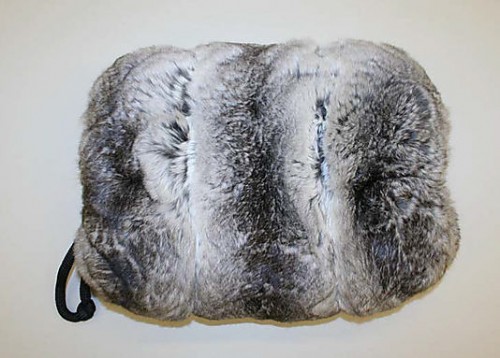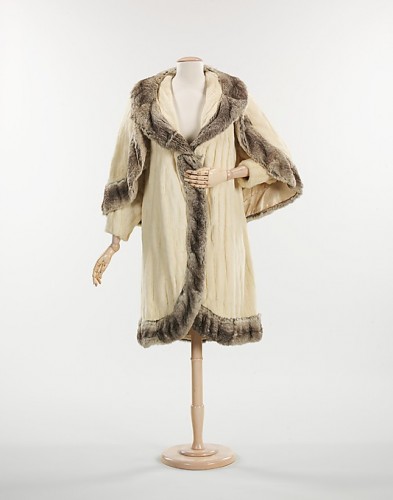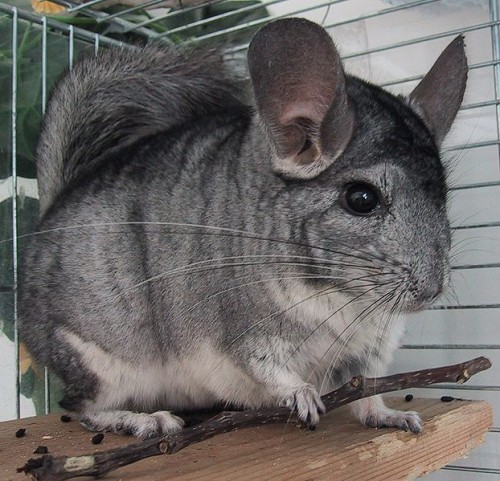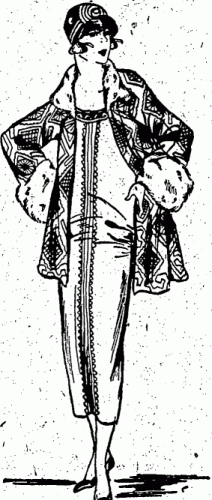I’m not much for fur, but chinchilla has always fascinated me. I think it is the name. It’s just so darn cute! It sounds like a name Disney would invent for an animal.
I’m never really thought about what a chinchilla actually was until recently. When I did begin to wonder, I had to look it up.
The chinchilla is a rodent from South America. It looks like this:
OH.MY.GOODNESS
Squeee!
Cute overload.
It’s a fat little mouse with extra big ears and a squirrel tail!
Awwwwwwwwwwwwwww!
I think they were invented by Disney!
Really, could you get any cuter if you tried?
I think we need to see more cuteness:
Awwwwwwwwwww!
Of course, in fashion they aren’t concerned with how gosh darn cute the fat little mice with big ears and fluffy squirrel tails are. They are concerned with how soft and dense the fur is, because they kill and skin those gosh darn cute fat little big-eared, fluffy-tailed mice for it.
Natural chinchilla fur is pale grey with a dark streak running along the tail, and incredibly soft and plush, because each hair follicle sprouts an average of 8 hairs. It is so soft and dense that chinchillas should not get wet – their thick hair traps the moisture, and they develop mold and skin rot.

Accessory Set Princeton Process, Inc. Manufacturer- The Brothers Christie Fur Corp.,1974, chinchilla fur, Metropolitan Museum of Art
The fur is so lovely that 16th century Spanish explorers in South America immediately noted the possibilities of the fur and started the fashion for it. Chinchilla went in and out of fashion over the next three centuries, and saw its greatest craze in the 2nd half of the 19th century, where cloaks and mantles were lavishly lined and trimmed in it.

The Countess de Castiglione by Pierre-Louis Pierson, 1862—67, Metropolitan Museum of Art "The Countess is shown here dressed in the latest fashion for the winter season of 1862-3. She wears a coatdress of lilac velvet, edged in red velvet cut into dents and a cloak edged with chinchilla. Her white bonnet is tied with red and white double strings, and she holds a chinchilla muff."
It was so popular that over-hunting caused the extinction of one species of chinchilla and the other species were both very rare by the end of the Victorian era. Chinchilla were so rare that the death of the only known chinchilla in North America in 1908 made international news.
The rarity led to the early 20th century development of the Chinchilla rabbit in France as a cheaper, more widely available, imitation chinchilla fur. It also had the benefit of being a meat species. The chinchilla rabbit, combined with the scarcity of the chinchilla, led to a rapid drop in the export of chinchilla fur from South America – 20,000 furs were exported from Chile in 1900, only 150 in 1925.
The drop in chinchilla exports certainly wasn’t because chinchilla was no longer fashionable. 1925 saw another peak in the chinchilla craze, with those who could afford it draping themselves in loose coats trimmed in chinchilla fur.

Evening coat of ermine with chinchilla trim by Jay-Thorpe, Inc., ca. 1925, American, Metropolitan Museum of Art
Notice how the coat above is ermine trimmed in chinchilla? That’s because real chinchilla was the most expensive and exclusive fur available in the 1930s. Those who had less resources had to content themselves with chinchilla rabbit. It wasn’t until 1929 that the popularity of chinchilla, real and rabbit (and all other furs) declined slightly. It’s return was hailed periodically throughout the 1930s as a sign that the depression was over, but both the end of economic hard times, and the return of chinchilla, were wishful thinking on the part of fashion editors.
Today it is illegal to hunt wild chinchilla, and chinchilla fur for the fashion industry is farmed. The popularity of chinchilla has been in steady decline since 1930. There was a brief revival in the 1970s, but people have been less inclined to wear fur in general. Today chinchillas are often pets rather than fashion accessories.
Anyone ever had a chinchilla or interacted with one as a pet? What are they like?
Sources:
O’Hara, Georgina, The Encyclopedia of Fashion: From 1840 to the 1980s. London: Thames and Hudson Ltd. 1986






I haven’t ever owned a chinchilla, but I have seen them in pet stores and they are really darned cute!
When my sister was young were we deciding on a family pet (eventually got a rabbit) and looked into owning chinchillas. I have heard that it is best to keep them in pairs – apparently they can get awfully lonely if they do not have constant company. They also have a fairly long life-span for a rodent, usually 12-20 years, though some people report having them for almost 30! They need to have a fairly sizable cage, as they need to be able to run around, and they also need to have a “dust bowl” where they can bathe in super fine dust particles (to prevent moisture from getting into their fur). They can be pretty expensive to own (initial cost is usually over $100USD per animal, plus cage, food, some places require you to have a permit to own them, etc.), and I have heard that they need to be in a fairly steady temperature controlled environment, but I have also heard that they are pretty quite (especially compared to guinea pigs) and usually amenable to cuddling. Other than price, they have been recommended to me as great pets.
I’ve owned two chinchillas, and yes to all of this. They do need a carefully controlled climate. One day I wasn’t home, and we had an unexpected wave of heat that day, that made the inside of my house very hot on a day that was usually mild. I didn’t expect it to get over 100 inside in APRIL. I got home to both of my babies dead.
They are wonderful little critters, pretty easy to own aside from making sure they don’t get too hot. They can get cool and survive well. It’s adorable watching them roll in dust, and more adorable watching them eat raisins, one of their favorite snacks, with their itty bitty hands.
Their fur is the softest fur known to man. It makes soft, soft rabbit feel rough in comparison. I can see why people wanted to use chinchilla fur. I’ve got no problem with fur from animals used for meat (it seems wasteful to toss the skins when an animal is eaten), but I’ve got a massive problem when animals like this, that aren’t eaten, are killed just for their fur, especially to near-extinction.
I can forgive anyone using old fur in a sewing project, but if their project includes new-killed animals for fur then I will hate them forever!
Actually I think I lied slightly in my over-emovtive statement above – I will only hate them if the fur was the only reason for the death of the animal. I don’t have a problem with rabbit pelts (if the rabbits are also used for meat) and I really have no problem with the way the peruvians use guinea-pigs. I think may be a hypocrit
I do think that raising and then killing an animal just for its pelt is completely wrong. Chinchillas fall within my “wrong” sphere. It is one of the softest and scrummiest fur – and I really love it when it is still attached to the owner – when detached there is no scrummy.
Sounds like you have a very similar attitude towards fur to me. Have you read my post on fur and meat?
Chinchillas are sweet pets, but they are hyperactive as all get-out and nocturnal, which means running around all night. I think even a fairly sizable cage isn’t really enough. They need to run AROUND. People who have them should be ready to let them run around the house/enclosed yard on a regular basis. Also giant chinchilla wheels are a must, but the thing that you’ll always hear banging in the middle of the night as they run and run and run on them.
SOOOOOOOOFT.
I had 2 chinchillas as pets a couple years ago a black one named hidalgo, and a grey named cappuccino (or cappy) they were so friendly and soft and cute! unfortunately they died within weeks of each other, an accident and unknown cause
My middle school science teacher had two chinchillas as classroom pets and we used to pass them around to cuddle during class. They were very cute and so luxuriously soft! I remember them as being fairly mellow and very tolerant of lots of fourteen-year-olds holding them.
Awwww …how fun! Sounds distracting too though
A friend told me they were much given to gnawing. I saw some in a cage at the vet’s, and there was indeed a structure in the cage made out of particle board. Or what was left of a stucture in the cage. That plus the nocturnal wheel work could be a bit wearing. I will stay with the cat.
But they are very, very, very cute! And should keep their fur – unless they become a plague, and someone works out a tasty recipe. After all, there is very little cuter than a mouse, and look what happens there. Mostly minus recipes, of course.
I’ve definitely heard of the gnawing, though if you saw what Felicity has done to the couch you might not advocate them as so much better! I’m definitely not thinking of getting one (cat + rodent has got to = bad).
Mice are cute. Every time Felicity catches one I rescue it and desperately want one as a pet. Even the wild ones are darling (rats, not so much!)
It is so odd to me that you have never seen one, as we have them in almost every pet shop here in in California! They always seem so skittish, I never really wanted one as a pet…. SO cute though!
I’ve had several pet chinchillas and their personalities vary as much as with any pet. Our first was pretty average in that regard but we’ve since had a skittish chinchilla, an aggressive chinchilla, a neurotic chinchilla, and a mellow chinchilla. They all love to chew because their teeth never stop growing – like a beaver. If they don’t chew and wear their teeth down, the teeth can grow up into their brains and kill them. Some of ours have required a lot of exercise but they have a huge cage and that tends to be enough for most. On the other hand, though, the one we have now is super lazy and is content to sit on the back of our sofa watching TV with us for hours whenever we take him out. He’ll also perch happily on my shoulder as I walk around the house – chinchillas love being up high or, if that’s not available, being in dark, close spaces. One of ours would hide behind the throw pillows every time we took him out and another got loose while we were away and got himself stuck under the dishwasher.
Chinchillas are very cute pets with their twitchy little noses and long whiskers (although rabbit noses are much twitchier). They use their front paws like little hands when they eat, which is incredibly adorable. They are a bit more expensive than other rodents but I would say the main problem is that their bathing dust gets EVERYWHERE. It’s so fine that it gets into the air and moves throughout the house, which can be a problem for people with allergies even though chinchillas do not produce dander. Some of them can be quite vocal, too, especially at night, while others will never make a peep.
I’ve really enjoyed having them as pets and couldn’t imagine anyone killing them for their skins – they’re just so cute!
The fur is so soft you almost can’t feel it when you pet it. It really does look nice on clothes but is a million times nicer/cuter on its original owner.
I’m with the above commenters. If an animal can be used for more than just its pelt and if it is killed quickly and painlessly and if its conditions while alive are peaceful and pleasant I am ok with using its pelt. I would wear leather when I can afford it. The cow has a decent life grazing in the fields. I imagine its death, while not 100% pleasant is quick and merciful. (Lots of laws in Canada that monitor that kind of thing). And I enjoy a hamberger just as much as the next guy. I don’t think there is to much that doesn’t get used in a cow. And there is no danger of extinction for cows at this point. If that were the case for a chinchilla I’d wear one too.
A childhood friend of mine had a couple of chinchillas. They really are the softest thing, creature ot otherwise, I’ve ever touched. I also recall they were friendly in a rodent kind of way. They would just sit in the crooks of our arms ans let us pet them. Then, they would bathe in the dust in the bottom of their cages and ruffle their fur in a facinating way.
I met a couple of chinchillas at a fiber farm, they weren’t raised for their skin but instead for their hairs. They brush them regularly, and mix their hair with soft wool and spin it. You can do the same thing with long haired rabbits. I think it’s a much better option. Killing and skinning such adorable animals must cause some sort of psychological damage, don’t you think?
The resulting yarn is almost as soft as the chinchillas and they were softer than any other animal I have met.
I have 5 chinchillas (an accident)4 are 1 year olds now and the other (only surviving parent) is 3 years old.
I have had chinchillas for about 6-7 years and it is true, they don’t like being alone. I am often away for a few days, hence keeping them together, boys in one cage, girls in another.
Often in the summer on a lead, just in case, I will take one of them shopping with me (usually the oldest) he sits on my shoulder and has a good look round while I do my shopping. This does make shopping take forever though, as all the children and a lot of adults want to have a look and a stroke.
I was asked by someone once if I was wearing real fur… I told them yes, but it’s still alive haha.
I am having my first chinchilla stuffed as he is rather special to me. but as the others die, as they must one day, I would not be averse to keeping their fur as they are part of my life.
I do wear fur, if it is not a meat animal it has to be old fur, I don’t believe in wasting life, if it is a meat animal, like cow or rabbit, I have no problem with it as I eat both.